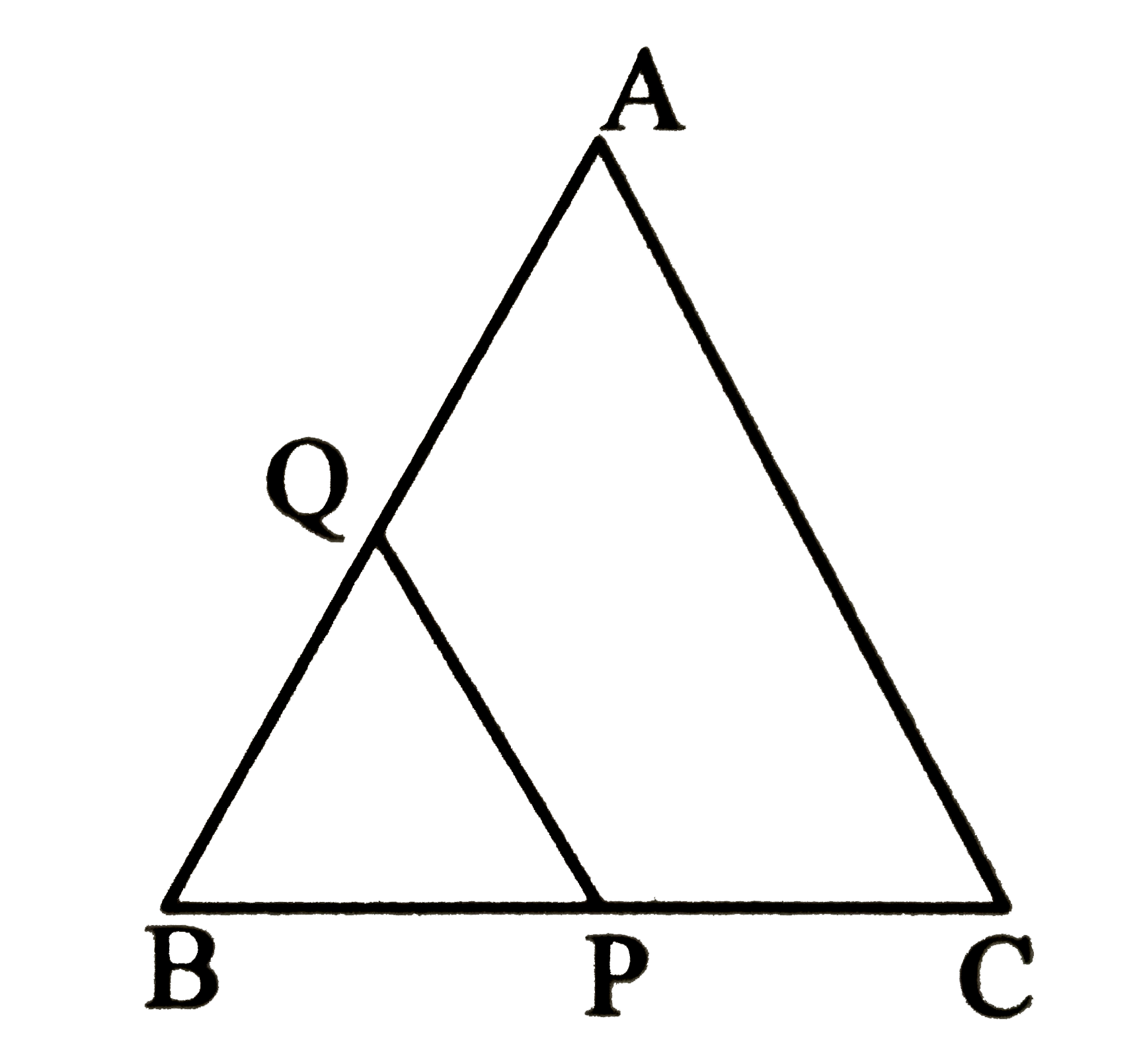In ΔABC, P is a point on BC such that BP : PC = 2 : 3 and Q is the midpoint of BP. Then ar (ΔABQ):ar(ΔABC) is equal to :
1:4
2:5
1:5
2:3
The correct Answer is:C
To solve the problem, we need to find the ratio of the area of triangle ABQ to the area of triangle ABC given the conditions about points P and Q.
1. Understand the Ratios: We are given that BP : PC = 2 : 3. This means if we let BP = 2x and PC = 3x, then BC = BP + PC = 2x + 3x = 5x.
2. Assign a Length to BC: For simplicity, let's assume BC = 10 cm. This gives us:
- BP = 2x = 4 cm (since 2/5 of 10 cm is 4 cm)
- PC = 3x = 6 cm (since 3/5 of 10 cm is 6 cm)
3. Identify Point Q: Q is the midpoint of BP. Therefore, the length of BQ = BP/2 = 4 cm / 2 = 2 cm.
4. Area of Triangle ABC: The area of triangle ABC can be calculated using the formula:
Area of ΔABC=12×Base×Height=12×BC×H=12×10×H=5H
5. Area of Triangle ABQ: The area of triangle ABQ can also be calculated using the same formula:
Area of ΔABQ=12×BQ×H=12×2×H=H
6. Calculate the Ratio: Now we can find the ratio of the areas:
Area of ΔABQArea of ΔABC=H5H=15
7. Final Result: Therefore, the ratio of the area of triangle ABQ to the area of triangle ABC is:
ar(ΔABQ):ar(ΔABC)=1:5
- BP = 2x = 4 cm (since 2/5 of 10 cm is 4 cm)
- PC = 3x = 6 cm (since 3/5 of 10 cm is 6 cm)
Area of ΔABC=12×Base×Height=12×BC×H=12×10×H=5H
Area of ΔABQ=12×BQ×H=12×2×H=H
Area of ΔABQArea of ΔABC=H5H=15
ar(ΔABQ):ar(ΔABC)=1:5
Similar Questions
In △ABC ,P is a point on BC such that BP : PC = 3 : 4 and Q is the midpoint of BP. Then ar(△ABQ):ar(△ABC) is equal to:
त्रिभुज ABC में, P, BC पर स्थित एक ऐसा बिंदु है कि BP : PC = 3 : 4 है और Q, BP का मध्य बिंदु है | ar(△ABQ):ar(△ABC) का मान ज्ञात करें |View SolutionIn △ABC ,P is a point on BC such that BP : PC = 4 : 3 and Q is the midpoint of BP. Then ar(△ABQ):ar(△ACB) is equal to:
त्रिभुज ABC में, P, BC पर स्थित एक ऐसा बिंदु है कि BP : PC = 4 : 3 है और Q, BP का मध्य बिंदु है | ar(△ABQ):ar(△ACB) का मान ज्ञात करें |View Solution
Knowledge Check
- Question 1 - Select One
In ΔABC, P is a point on BC such that BP:PC=4:5 and Q is the mid - point of BP. Then area (ΔABQ) : area (ΔABC) is equal to :
A1:3B1:9C2:9D2:5 - Question 2 - Select One
ABC and BDE are two equilateral triangles such that D is the mid-point of BC. Then, ar(ΔBDE)=12ar(ΔABC).
ATrueBFalseCPartially trueDNone of these
In △ABC ,P is a point on BC such that BP : PC = 4:5 and Q is the midpoint of BP. Then ar(△ABQ):ar(△ABC) is equal to:
त्रिभुज ABC में, P, BC पर स्थित एक ऐसा बिंदु है कि BP : PC = 4:5 है और Q, BP का मध्य बिंदु है | ar(△ABQ):ar(△ABC) का मान ज्ञात करें |View SolutionIn △ABC ,P is a point on BC such that BP : PC = 4 : 11 and Q is the midpoint of BP. Then ar(△ABQ):ar(△ABC) is equal to:
त्रिभुज ABC में, P, BC पर स्थित एक ऐसा बिंदु है कि BP : PC = 4 : 11 है और Q, BP का मध्य बिंदु है | ar(△ABQ):ar(△ABC) का मान किसके बराबर होगा ?View SolutionIn △ABC ,P is a point on BC such that BP : PC = 2 : 3 and Q is the midpoint of BP. Then (△ABQ):(△ABC) is equal to:
त्रिभुज ABC में, P, BC पर स्थित एक ऐसा बिंदु है कि BP : PC = 2 : 3 है और Q, BP का मध्य बिंदु है | (△ABQ):(△ABC) ज्ञात करें |View SolutionIn △ABC ,P is a point on BC such that BP : PC = 1 : 2 and Q is the mid point of BP. then, ar(△ABQ):ar(△ABC) is equal to:
त्रिभुज ABC में, P, BC पर स्थित ऐसा बिंदु है कि BP : PC = 1 : 2 है और Q, BP का मध्य बिंदु है | तो ar(△ABQ):ar(△ABC) का मान क्या होगा ?View SolutionA(4,3),B(6,5)andC(5,−2) are the vertices of a ΔABC, if P is a point on BC such that BP:PC=2:3. Find the co-ordinates of P and then prove then ar (ΔABP):ar(ΔACP)=2:3.
View SolutionIn the figure, ΔABC~ΔBPQ. If AB = BC and P is the midpoint of seg BC, then A(ΔABC):A(ΔBPQ)=
 View Solution
View Solution

